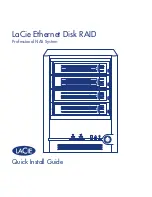
Refer to “Supported transceivers and cables” on page 65 for a list of qualified transceivers for blade
ports.
The following table defines the eight-port Fibre Channel port groups for configuring trunk groups or
"trunks." Color coding on the physical blade identifies the port groups. On the blade, ports belonging to
the same port group are indicated with the same color border beneath the port on the blade label. Ports
belonging to the same ASIC are indicated by a border with a similar color tone.
Table 25. Port groups for configuring
trunks
Port number
Port group
0– 7
0
8–15
1
16–23
2
24–31
3
32–39
4
40–47
5
Following are the requirements for forming trunk groups:
v
All ports in a trunk group must belong to the same port group. For example, to form an 8-port trunk
select all eight ports from port group 0 or port group 1. You cannot use ports from each port group for
the trunk.
v
You can use from 1–8 ports in a port group to form a trunk.
v
All ports in a trunk must be running at the same speed.
v
All ports in a trunk must be configured for the same distance.
v
All ports in a trunk must have the same encryption, compression, QoS, and FEC settings.
v
Trunk groups must be created between Brocade switches (or Brocade adapters in the case of F_Port
trunking). Brocade trunking is proprietary and is not supported on M-EOS or third-party switches.
v
There must be a direct connection between participating switches.
FC32-64 port blade overview
The FC32-64 port blade contains 16 QSFP28 ports. Each QSFP port has four front SFP+ ports for
connecting FC devices. With a breakout cable connected to the QSFP transceiver, SFP+ connections are
provided for up to four devices. Connection speeds depend on the QSFP transceiver installed. For
example, a 4x32 Gbps QSFP+ transceiver would provide four 32/16 Gbps connections and a 4x16 Gbps
QSFP+ transceiver provides four 16/8/4 Gbps connections.
1.
FC ports 0-23 (numbered right to left)
2.
FC ports 24-47 (numbered right to left)
Figure 52. FC32-48 blade port numbering
114
SAN256B-6 Installation, Service, and User Guide
|
|
|
|
|
|
|
|
|
|
|
|
||
|
||
||
||
||
||
||
||
|
|
|
|
|
|
|
|
|
|
|
|
|
|
|
|
|
|
Summary of Contents for SAN256B-6
Page 6: ...vi SAN256B 6 Installation Service and User Guide...
Page 10: ...x SAN256B 6 Installation Service and User Guide...
Page 22: ...xxii SAN256B 6 Installation Service and User Guide...
Page 24: ...xxiv SAN256B 6 Installation Service and User Guide...
Page 34: ...6 SAN256B 6 Installation Service and User Guide...
Page 72: ...44 SAN256B 6 Installation Service and User Guide...
Page 92: ...64 SAN256B 6 Installation Service and User Guide...
Page 108: ...80 SAN256B 6 Installation Service and User Guide...
Page 152: ...124 SAN256B 6 Installation Service and User Guide...
Page 162: ...134 SAN256B 6 Installation Service and User Guide...
Page 198: ...170 SAN256B 6 Installation Service and User Guide...
Page 206: ...178 SAN256B 6 Installation Service and User Guide...
Page 210: ...182 SAN256B 6 Installation Service and User Guide...
Page 214: ...186 SAN256B 6 Installation Service and User Guide...
Page 218: ...190 SAN256B 6 Installation Service and User Guide...
Page 258: ...230 SAN256B 6 Installation Service and User Guide...
Page 278: ...250 SAN256B 6 Installation Service and User Guide...
Page 286: ...258 SAN256B 6 Installation Service and User Guide...
Page 289: ...WWN card power down replacement 156 Index 261...
Page 290: ...262 SAN256B 6 Installation Service and User Guide...
Page 291: ......
Page 292: ...IBM Part Number 01JC333 Printed in USA SC27 8967 03 1P P N 01JC333...
















































